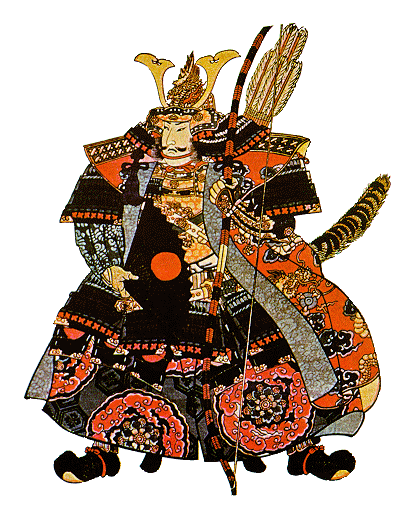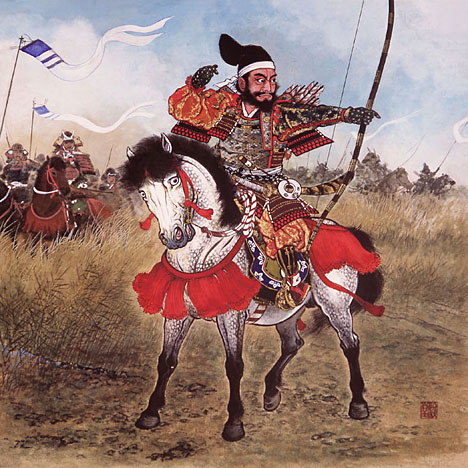Samurai emerged in Japan during the late Heian Period. Exactly
how the first samurai developed is still unknown, but there are many explanations
why. The conventional hypothesis suggests that the imperial and regent
governments were too politically weak to control much of Japan outside
of Nara, the capital at the time. Thus, the samurai developed to
protect their property, and in doing so provided some degree of stability
and peace in the countryside. Private landlords began maintaining
arms and rallying around particularly powerful and wealthy members of their
group (Friday 4). This movement soon became a system with lord-vassal
relationships (akin to European feudalism) and was, for all intents and
purposes, the true power in the countryside.
 Historian
Karl F. Friday offers a different theory. In his view, the development
of the samurai was due to the imperial government’s action rather than
its inaction or inability to regulate Japanese affairs. From the
eighth century on, it was increasingly the policy of the emperor to use
the armed, landed classes in the countryside rather than drafted peasant
armies. It was to the court’s direct advantage, Friday argues, to
rely on these professional warriors because they were better-armed, better-funded,
and more effective (Friday 7). Historian
Karl F. Friday offers a different theory. In his view, the development
of the samurai was due to the imperial government’s action rather than
its inaction or inability to regulate Japanese affairs. From the
eighth century on, it was increasingly the policy of the emperor to use
the armed, landed classes in the countryside rather than drafted peasant
armies. It was to the court’s direct advantage, Friday argues, to
rely on these professional warriors because they were better-armed, better-funded,
and more effective (Friday 7).
Finally, there is an attempt to produce a synthesis using both of these
explanations. Eiko Ikegami, a Fulbright scholar who obtained her
doctorate degree at Harvard University, contends that it is overly simplistic
to assume either economic necessity or the current military situation alone
produced the samurai. According to Ikegami, both factors played a
decisive role in the order’s creation. She goes even further to say
that one must also consider the unique social nature of the samurai.
By taking on the roles of soldiers and landlords, samurai became the authority
figures that had been missing (Eiko 55-56).
However the samurai originated, they certainly became an integral part
of Japanese society. By the time the Kamakura Shogunate began its
rule in 1185, the samurai system was well defined. Though the power
relationship between the regional lords and individual samurai remained
largely unaffected, the new shogunate placed a lord, or daimyo, directly
under the its control. The daimyo then provided each samurai a plot
of land from which they could collect taxes. The samurai remained
soldiers in times of war but otherwise were overseers and administrators
of their individual parcels of land (Mikiso 21-22).
 In addition
to having political power, the samurai were a distinct social class that
practiced a strict code of living. This code, known as bushido,
drew on the tenets of both Zen Buddhism and Confucianism and called for
samurai to abide by the principles of detachment, diligence, honor, and
loyalty. Besides learning the arts of horsemanship and archery, samurai
had the right to bear a sword, and spent years learning to use it properly.
This sword helped not only on the battlefield, but also on his own fields,
as the samurai were able to administer justice to peasants who failed to
pay them enough respect. Being a samurai was not merely a source
of livelihood or a way of making a living; it was a source of strength
and a way of life (Eiko 54). In addition
to having political power, the samurai were a distinct social class that
practiced a strict code of living. This code, known as bushido,
drew on the tenets of both Zen Buddhism and Confucianism and called for
samurai to abide by the principles of detachment, diligence, honor, and
loyalty. Besides learning the arts of horsemanship and archery, samurai
had the right to bear a sword, and spent years learning to use it properly.
This sword helped not only on the battlefield, but also on his own fields,
as the samurai were able to administer justice to peasants who failed to
pay them enough respect. Being a samurai was not merely a source
of livelihood or a way of making a living; it was a source of strength
and a way of life (Eiko 54).
Among all samurai responsibilities, there was one that was almost sacrosanct:
their duty to conduct themselves honorably. Issues surrounding honor
affected all Japanese, from the lowliest peasant to the most powerful shogun,
but it was especially important for the samurai. It had developed
into a sense of identity for the warrior class, for several reasons.
Initially, the samurai were bound to honor their oaths to their lords.
They controlled a certain amount of property and were obliged to oversee
it fairly. Finally, the samurai were a military culture, and battlefield
heroics were literally the stuff of legend in samurai circles. To
flee a fight or even perform in a way unbecoming of a samurai was not an
option. As the class evolved, this honor became its focal point (Eiko
29-30).
It was honor that created such a problem for Sanjuro in 1642.
According to his own code of living, seppuku should have been enough to
end the issue. Why then did that incident lead to bigger problems
for local authorities?
The reason is that the samurai class had changed dramatically under
the Tokugawa Shogunate. No longer were they a true military order;
that ended with the arrival of the foreign presence in 1543. Historian
John Dos Passos wrote the account of Mendes Pinto, a Portuguese merchant
who told of the first Japanese encounter with guns:
One of his companions went hunting
on the island one morning and came back with his two coolies loaded with
game. The Japanese had never seen a musket. The local daimyo
immediately sent for the Portuguese and asked to be shown how the machine
worked. The Portuguese promptly shot him two wild pigeons and a hawk.
It seemed enchantment but the Portuguese explained it was merely the effect
of gunpowder. The daimyo bought the musket for a thousand taels of
silver and made the Portguese promise to teach him how to make gunpowder.
The daimyo had his armorer copy the musket. When, at the end of four
months, the Portuguese and their Chinese friends departed . . . there were
six hundred muskets on the island
(Dos Passos 335-336).
For the local daimyo, this was an incredible stroke of luck. For
this was the Sengoku era, a time when the daimyo struggled against each
other to see who would become the next shogun. Military force was
the top priority, and the local daimyo had stumbled upon technology that
would boost his strength considerably. For the samurai, it was the
beginning of the end of life as they knew it. They had trained for
a lifetime to become masters of the sword. Now a peasant could become
a more effective fighter in a fraction of the time.
Having little to do on the actual field of battle, some samurai decided
to study tactics and become officers. The majority, however, became
government officials, positions that were hereditary, preventing the development
of civil service exams like those in China. Samurai received a stipend
and could not become actual landholders, but were still nominally the top
of the social order. Without land, and precluded from being merchants
by their own code of living, few of these former warriors became wealthy
or truly dominated the social scene. Though they were acknowledged
as the elite, the samurai simply could not obtain the wealth necessary
to actually establish themselves in that position (Chie and Shinzaburo
213, 227).
With the changes in lifestyle came debates about the old samurai values.
Did they still have the same sense of loyalty to the ruling Tokugawa?
How should a samurai carry himself now that he spent his time in front
of a desk rather than on a battlefield? Perhaps most important, was
honor still a priority for these men who were now merely bureaucrats instead
of warriors?
Incidents like Sanjuro’s helped forward these debates and eventually
settle some of them. Though there were still episodes of seppuku
and vengeance, the majority of samurai developed a new spirit that emphasized
defensiveness and a desire to live safely (Eiko 260). Instead of
training with their swords or plotting to avenge a lord’s death, samurai
were now able to enjoy the spoils of peace: the flowering of Japanese culture.
New and exciting forms of entertainment and art were appearing, and samurai
helped them evolve. Samurai also participated in tea ceremonies,
listened to joruri, a “type of music usually played at puppet theaters,
and played a Japanese game akin to chess" (Eiko 261). The samurai
even found themselves to be the subjects of plays in the new kabuki style
of theater (Chie and Shinzaburo 207-208).
|

 Historian
Karl F. Friday offers a different theory. In his view, the development
of the samurai was due to the imperial government’s action rather than
its inaction or inability to regulate Japanese affairs. From the
eighth century on, it was increasingly the policy of the emperor to use
the armed, landed classes in the countryside rather than drafted peasant
armies. It was to the court’s direct advantage, Friday argues, to
rely on these professional warriors because they were better-armed, better-funded,
and more effective (Friday 7).
Historian
Karl F. Friday offers a different theory. In his view, the development
of the samurai was due to the imperial government’s action rather than
its inaction or inability to regulate Japanese affairs. From the
eighth century on, it was increasingly the policy of the emperor to use
the armed, landed classes in the countryside rather than drafted peasant
armies. It was to the court’s direct advantage, Friday argues, to
rely on these professional warriors because they were better-armed, better-funded,
and more effective (Friday 7).
 In addition
to having political power, the samurai were a distinct social class that
practiced a strict code of living. This code, known as bushido,
drew on the tenets of both Zen Buddhism and Confucianism and called for
samurai to abide by the principles of detachment, diligence, honor, and
loyalty. Besides learning the arts of horsemanship and archery, samurai
had the right to bear a sword, and spent years learning to use it properly.
This sword helped not only on the battlefield, but also on his own fields,
as the samurai were able to administer justice to peasants who failed to
pay them enough respect. Being a samurai was not merely a source
of livelihood or a way of making a living; it was a source of strength
and a way of life (Eiko 54).
In addition
to having political power, the samurai were a distinct social class that
practiced a strict code of living. This code, known as bushido,
drew on the tenets of both Zen Buddhism and Confucianism and called for
samurai to abide by the principles of detachment, diligence, honor, and
loyalty. Besides learning the arts of horsemanship and archery, samurai
had the right to bear a sword, and spent years learning to use it properly.
This sword helped not only on the battlefield, but also on his own fields,
as the samurai were able to administer justice to peasants who failed to
pay them enough respect. Being a samurai was not merely a source
of livelihood or a way of making a living; it was a source of strength
and a way of life (Eiko 54).